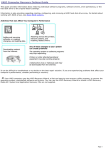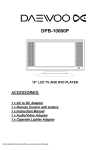Download Sony PCV-W30 User's Guide
Transcript
Welcome Thank you for purchasing your Sony VAIO® computer! Your new computer is a superb blend of high technology and easy-to-use functionality. The information provided here is designed to help you to become familiar with the hardware and software applications included with your system. View the Electronic Flyer, which provides updates and supplemental information about your computer. View the VAIO® Computer Specifications, which lists your computer's hardware specifications and preinstalled software information. Page 1 Getting Started Congratulations on your purchase of the Sony VAIO® computer! Your new, high-performance, multimedia computer combines state-of-the-art computer functionality with the latest audio, video and information technology features. Unpacking your Computer Planning An Ergonomic Work Space Page 2 Unpacking your Computer Your computer may not be supplied with all of the accessories shown, depending on the system configuration you purchased. For details on the accessories supplied with your computer, see the online Specifications sheet. Com puter and supplied accessories Handling the system unit Manuals VAIO® Computer Quick Start — Provides basic information on setting up and registering your computer. The Quick Start also provides resources for technical support, safety guidelines and owner's information. Microsoft® Windows® XP Guide — Explains how to use the basic features of the latest Windows operating system. Online Documentation VAIO® Computer User Guide — Contains information on the hardware and preinstalled software applications included with your system. To access the online User Guide: 1. Click Start in the Windows taskbar, then click Help and Support. 2. From the VAIO Help and Support Center menu, click VAIO User Guide. Page 3 Specifications — This online specifications sheet describes the hardware and software configuration of your VAIO computer. To view this online information: 1. Click Start in the Windows taskbar, then click Help and Support. 2. From the VAIO Help and Support Center menu, click VAIO User Guide. 3. Click the Welcome link. The Welcome page displays in the right-side frame. 4. Locate the link in the text, "View the VAIO® Computer Specifications..." Hard Disk Drive Recovery Your computer is equipped with a utility program that enables you to recover your computer's operating system and preinstalled software. For more information about hard disk drive recovery: Your VAIO® computer is not supplied with System or Application Recovery CDs. Use the VAIO Recovery utility to recover your computer's operating system and preinstalled software. 1. Click Start in the Windows ® taskbar, then click Help and Support. 2. From the VAIO Help and Support Center menu, click VAIO Recovery Options. Other Software Library containing the Microsoft software license agreement and Sony end-user license agreement. Page 4 Planning An Ergonomic Work Space Before you set up your new computer, find the best location for your new computer and plan your work space. There are several ergonomic factors to consider when you arrange your work space: Stable work surface — Use a stable work surface large enough to support the computer and other peripheral equipment. Ventilation — Leave at least eight inches of space on both sides of your computer and at least 5 inches of clearance for the back. Placement of the mouse and other input devices — Place your computer, mouse, or other input devices so that your arms and hands are in a relaxed, comfortable position. The computer's keyboard should be directly in front of you. Keep your wrists in a relaxed position when you are using the keyboard—not angled up or down. Position the mouse at the same level as the keyboard. Hold the mouse with a relaxed hand, and use your whole arm to move it. Take breaks during sessions with your computer. Excessive use of the mouse or a joystick may strain muscles or tendons. Furniture and posture — Sit in a chair with good back support and armrests. Adjust the level of the chair so your feet are flat on the floor. A footrest may make you more comfortable. Sit with relaxed, upright posture—avoid slouching forward or leaning far backward. Viewing angle of the display — Position the unit so that the display is 18 to 26 inches directly in front of you, with the top of the screen at or a little below eye level. Use the display's tilting feature to find the best position. You can reduce eye strain and muscle fatigue by placing the display in the proper position. Lighting — Choose a location where windows and lights do not create glare and reflection on the display. Use indirect lighting to avoid bright spots on the display. You can also purchase accessories for your display that help reduce glare. Proper lighting adds to your comfort and work effectiveness. Page 5 Locating Controls And Ports This section is intended to familiarize you with the controls, ports and jacks that are available on your computer. To view the specific hardware configuration for your system, see the online specifications sheet. i.LINK is a trademark of Sony used only to designate that a product contains an IEEE 1394 connection. The i.LINK connection may vary, depending on the software applications, operating system, and compatible i.LINK devices. All products with an i.LINK connection may not communicate with each other. Please refer to the documentation that came with your compatible i.LINK device for information on operating conditions and proper connection. Before connecting compatible i.LINK devices to your system, such as an optical or hard disk drive, confirm their operating system compatibility and required operating conditions. About the Front Panel About the Side Panels Page 6 About the Front Panel The front panel of your VAIO® computer is equipped with built-in stereo speakers and indicator lights. Opening the com puter Front panel 1 Stereo speakers (built-in) The stereo speakers provide sound for software, audio and video CDs. 2 Liquid Crystal Display (LCD) screen The attached LCD screen provides on-screen visual output to your computer's functional capabilities. 3 Memory Stick® media access indicator Light is amber when the Memory Stick media slot is in use. Page 7 4 CD-RW/DVD combo drive access indicator Light is amber while reading and writing data from and to the combo drive. 5 Power button Turns the computer on and off. 6 Hard disk drive access indicator Light is amber while reading and writing data from and to the hard disk. 7 Power indicator Light is green while the power is on and amber when the computer is in Stand by mode. 8 Shortcut keys (S keys) Programmable function keys that launch specific applications. 9 Keyboard The attached keyboard has programmable buttons for launching your favorite software applications or accessing the Internet. Page 8 About the Side Panels The side panels of your computer contain the connections for supplied and optional accessories. The icons on the side panels help to locate and identify the connections on your computer. Right panel 1 Headphones jack Connection for optional speakers or headphones. 2 Line In jack Connection for an audio device. 3 Microphone jack Connection for a microphone (optional). 4 Modem line jack Connection for the modem (supplied) cable to the wall jack. 5 Telephone jack Connection for a telephone cable (optional) to the computer. 6 i.LINK 4-pin S400 ports (2) Page 9 Connections for i.LINK compatible digital devices (IEEE 1394). 7 CD-RW/DVD combo drive eject button Ejects a disc from the combo drive. 8 Ethernet port Connection for a 10BASE-T/100BASE-TX Ethernet. (The port marked with 9 (Network) is for LAN connections only.) Universal Serial Bus (USB 2.0) ports (3) Connections for compatible high/full/low-speed USB devices. 10 CD-RW/DVD combo drive Reads data from compatible CD or DVD media. Writes data to a CD-R or CD-RW media. 11 PC Card slots (2) A PC Card, also called a PCMCIA Card, can be inserted into these slots to increase your computer's functional capabilities. Left panel 1 Brightness control dial Adjusts the contrast and brightness of the built-in LCD monitor. 2 Volume control dial Increases or decreases the speaker volume. Page 10 3 Memory Stick® media slot Reads and writes data from a Memory Stick media. 4 AC Input port Connection for the supplied power cord. Page 11 Setting Up Your Computer You can set up your system quickly and easily with the instructions provided in this section. For details on your system's hardware configuration, see the online specifications sheet. Install your equipment so that you can easily reach the power outlet in the event of an emergency. Connecting a USB Optical Mouse Connecting the Telephone and Modem Cables Connecting the Power Cord Turning on Your Computer Registering your Computer Page 12 Connecting a USB Optical Mouse 1. Plug the USB optical mouse connector into the USB mouse port, located on the right panel of your computer. 2. Place the optical mouse on an appropriate surface to enable precision tracking. To connect a USB m ouse To use an optical mouse An optical mouse requires an ideal surface texture in order to provide precision pointing and tracking. Use surfaces such as plain paper, card stock, or fabric that have minimal repetitive patterning. Avoid surfaces such as mirrors, smooth glass, or magazines that have half- tone printing. Page 13 Connecting the Telephone and Modem Cables Your supplied accessories may include a ferrite core. The ferrite core is designed to reduce or eliminate electrical interference when a telephone is connected to your computer. 1. Unplug your telephone's cable from the wall jack. 2. Open the supplied ferrite core and place the ferrite core approximately 3-4 inches from the end of the telephone cable. 3. Wrap the telephone cable twice around the ferrite core, lengthwise, with the cable running directly through the center groove of the core. 4. Close the ferrite core tightly around the telephone cable until it locks. Attaching the ferrite core 5. Unplug your telephone cable from the wall jack. 6. Plug the telephone cable into the telephone jack on the right panel of your computer. 7. Plug the modem cable (supplied) into the modem line jack on the computer. 8. Plug the other end of the modem cable into the wall jack. To connect the telephone and m odem cables Page 14 Your computer has a protective sticker covering the Ethernet port located on the rear panel. Connect only 10BASE-T and 100BASE-TX cables to the Ethernet port. Using other cables or a telephone cable may result in an electric current overload that can cause a malfunction, excessive heat, or fire in the port. For help on connecting to a network, see your network administrator. Page 15 Connecting the Power Cord 1. Plug the power cord into the AC input port on the left panel of the computer. 2. Plug the power cord into a grounded AC wall outlet or a power strip. To connect the power cord Page 16 Turning on Your Computer Initially when you start your system, the computer may detect new hardware and prompt you to restart your computer. Respond to this prompt immediately. Press the power button on the computer to turn on the system. To turn on your com puter Page 17 Registering your Computer Take advantage of Sony's commitment to quality customer support and receive these benefits by registering your computer: Sony Customer Support — Communicate with a Support Representative to troubleshoot problems you may be having with your computer. Limited warranty — Protect your investment. See the Limited Warranty Card for more details. You are prompted to register your computer the first time you turn on the unit. Follow the on-screen instructions to complete the registration process. If you are not able to register your computer during the first session, you are provided with additional registration opportunities later. Page 18 Configuring Your VAIO Computer This section provides basic information about managing your computer's hard disk drive performance, using i.LINK devices, Memory Stick media, PC Cards, and changing default settings. About i.LINK Compatibility About the Memory Stick Media Slot About the PC Card Slot VAIO Action Setup Page 19 About i.LINK Compatibility Your VAIO® computer may be equipped with a 4-pin and/or a 6-pin i.LINK® port, depending on the system configuration purchased. A 4-pin i.LINK port cannot supply power to a connected i.LINK device. A 6-pin i.LINK port can supply power (10V to 12V) to a connected i.LINK device, if the device is equipped with a 6-pin connector. To view the hardware configuration for your computer, see the online specifications sheet. The total power supplied by the 6-pin i.LINK port cannot exceed 6 watts. For PCV-W series models only Your PCV-W series computer has two 4-pin i.LINK ports available to connect your digital devices. The 4-pin i.LINK ports do not supply power to a connected i.LINK device. i.LINK is a trademark of Sony used only to designate that a product contains an IEEE 1394 connection. The i.LINK connection may vary, depending on the software applications, operating system and compatible i.LINK devices. All products with an i.LINK connection may not communicate with each other. Please refer to the documentation that came with your compatible i.LINK device for information on operating conditions and proper connection. Before connecting compatible i.LINK devices to your system, such as an optical or hard disk drive, confirm their operating system compatibility and required operating conditions. Page 20 Connecting an i.LINK (IEEE 1394) device 1. Use the symbol to locate the i.LINK port on your compatible i.LINK device and on your computer. Plug the i.LINK cable connector into this port. 2. Plug the other end of the cable into the corresponding 4- or 6-pin i.LINK port on your computer. See the instructions that came with your i.LINK device for more information on installation and use. Page 21 VAIO Action Setup VAIO® Action Setup manages the settings for your computer's Shortcut keys (S Keys). Page 22 Shortcut keys The programmable S Keys are set to launch the following applications: S1 Mail — Microsoft® Outlook® Express S2 Internet — Microsoft® Internet Explorer S3 Music — SonicStage S4 Picture — PictureGear Studio S5 DVD — PowerDVD S6 Help — VAIO Help Center PCV- W series keyboard Page 23 Changing the settings of the S keys You can reprogram the S keys to launch other applications. 1. Click Start in the Windows taskbar and select All Programs. 2. Select S-key settings (VAIO Action Setup), then click VAIO Action Setup. You can also double-click Setup. the VAIO Action Setup icon, located in the Windows taskbar, to launch VAIO Action 3. Click the S Key you want to change. 4. From the Select Application dialog box, click the option for the desired type of function. The corresponding applications appear in the list box on the right. 5. Select an application from the list. Click Next. You can drag an application to place it into the list box. 6. The Confirmation Application Name window appears. Click Next. 7. You may now type a new name and description, if desired. Then click Finish. Page 24 About the Memory Stick Media Slot Your VAIO® computer is equipped with a Memory Stick® slot that supports certain types of Memory Stick® media. Page 25 About Memory Stick media Memory Stick® media are a compact, portable, and versatile data storage media designed for exchanging and sharing digital data with compatible devices. The following types of Memory Stick media are available, but compatibility with your computer can vary. MagicGate Memory Stick® media (MagicGate Memory Stick media) — Provides copyright protection with authentication and encryption, using Sony® MagicGate technology. Authentication ensures that protected content is only transferred between compliant devices and media. Protected content can be recorded and transferred in an encrypted format that prevents unauthorized duplication or playback. You can store different data formats on a single Memory Stick media. Memory Stick PRO media — Provides MagicGate copyright protection and high-speed data transfer features when used with compatible Memory Stick PRO devices. VAIO® computers support Memory Stick PRO media for data storage purposes only. Currently, high-speed data transfer and the MagicGate technology features, such as authentication and encryption, are not available. You can store different data formats on a single Memory Stick media. Memory Stick® media — Provides data storage only. The Memory Stick media does not provide MagicGate technology or high-speed data transfer. You can store different data formats on a single Memory Stick media. Currently, Sony® SonicStage and OpenMG software are not compatible with the new Memory Stick PRO media. Sony suggests using only MagicGate Memory Stick media to store and transfer any data created with SonicStage or OpenMG software. Visit the Sony Computing Support Web site at http://www.sony.com/pcsupport regularly for the latest information on Memory Stick® media. Memory Stick media do not support video file playback directly from the media. Copy the video file to your hard disk drive and then play back the file. Page 26 To insert a Memory Stick media 1. Insert the Memory Stick media into the Memory Stick media slot, located on the left panel. Inserting a Mem ory Stick m edia 2. If the media does not insert easily, remove it from the slot and verify that it is not upside-down or backwards. Carefully reinsert the Memory Stick media, but do not force it into the slot. Page 27 To remove a Memory Stick media A small portion of the Memory Stick media remains extended when it is inserted into the Memory Stick media slot. 1. Press the extended Memory Stick media to release it from the Memory Stick slot. The media extends further, enabling you to grasp it. 2. Remove the Memory Stick media from the slot. Rem ov ing a Mem ory Stick Media Do not remove the Memory Stick media while the media access indicator light is on. The media or its data may become damaged. Memory Stick media do not support AVI file playback. Copy the AVI file to your hard disk drive before attempting to play back the file. Page 28 Protecting data on Memory Stick media from accidental changes Memory Stick media contain a write-protect tab. The write-protect tab prevents accidental changes to information recorded on your Memory Stick media. When you slide the write-protect tab to the LOCK position, your Memory Stick media is write-protected. You cannot delete, copy, or save information on the media while the write-protect tab in the LOCK position. When you slide the tab to the un-LOCK position, you can write to or modify your Memory Stick media's contents. Locking the Mem ory Stick Media Page 29 About the PC Card Slot Your computer has a card bus PC Card slot that supports Type I or Type II PC (PCMCIA) Cards. You do not need to shut down your computer when inserting a PC Card. For more information, see the instructions supplied with your PC Card. Page 30 Inserting a PC Card 1. With the label facing upwards, insert the PC Card into the PC Card slot. Inserting a PC Card 2. Push the PC Card gently into the slot. The card is automatically detected and the icon appears in the Windows® taskbar. Safely Remove Hardware If the PC Card does not insert easily, remove it from the PC Card slot and verify that it is not upside-down or backwards. Carefully reinsert the PC Card, without forcing it into the slot. Page 31 Removing a PC Card 1. Close all applications that may access the PC Card to avoid data loss. 2. Double-click the 3. Click to select the name of the card that you want to eject and click Stop. The Stop a Hardware Device window appears. Click OK. 4. When the message "Safe to Remove Hardware" appears, push the PC Card Eject button on the right panel of the system unit. Be sure to extend the Eject button out from the computer before attempting to eject the card. Safely Remove Hardware icon in the Windows® taskbar. Rem ov ing a PC Card 5. When the PC Card ejects from the PC Card slot, remove the card by holding the edges and pulling it out carefully. If you eject the PC Card incorrectly, your computer may not work properly. Page 32 Upgrading and Maintaining your VAIO Computer In the future you may want to increase the functionality of your VAIO computer. This section provides information about upgrading and maintaining your system. Overview Installing Memory Replacing the Lithium Battery Replacing a Hard Disk Drive Page 33 Overview Sony recommends that you contact your local dealer for upgrade or maintenance of your new computer. Your local dealer is knowledgeable of this specialized personal computer and familiar with the safety practices and regulatory compliance required for using and modifying electronic equipment. To view the hardware configuration for your computer, see the online specifications sheet. Page 34 Installing Memory The amount of preinstalled memory may vary, depending on the system configuration you purchased. Your computer may ship with all available memory slots filled. See the online specifications sheet for details about the memory installed in your computer. Do not attempt to remove or replace the memory modules. Contact your local dealer for memory replacement and upgrades. Page 35 Replacing the Lithium Battery The lithium battery weakens after several years and the system settings, such as the date and time stored in CMOS RAM, may become inaccurate. If this occurs, contact your local dealer to replace the lithium battery. There is danger of the battery exploding if it is replaced incorrectly. Contact your local dealer to replace the lithium battery. Replace the battery only with a CR2032-type lithium battery. Dispose of the lithium battery properly. In some areas, the disposal of lithium batteries in household or business trash may be prohibited. You can return your unwanted lithium batteries to your nearest Sony Service Center or Factory Service Center. To locate a Service Center near you, visit the Sony Computing Web site at http://www.sony.com/pcsupport. Page 36 Replacing a Hard Disk Drive Your computer has an installed ATA-100, 3½-inch hard disk drive. Do not attempt to replace the hard drive. Contact your local dealer for replacement or upgrade of the hard disk drive. About Replacing the original hard disk drive If you replace the original, factory-installed hard disk drive, your system cannot restore the drive partitions, operating system, or original software, using the preinstalled Hard Drive Recovery utility. The Hard Drive Recovery utility is a quick and easy-to-use program that can restore your system if it becomes unstable or stops working properly. To enable you to recover your system with the VAIO Recovery utility, you can purchase a Partition Recovery CD Assembly (Partition Recovery ASSY) to restore your system. Follow these steps to order the Partition Recovery CD Assembly: 1. Connect to the Internet. 2. Go to the Sony Direct Accessories and Parts Center Web site at http://servicesales.sel.sony.com. 3. In the section, Search by Model for Accessories, type in your computer model and click List Parts and accessories. 4. From the list of accessories, locate the Partition Recovery ASSY and click the option, Add to Cart. 5. Click Continue to Check Out, and follow the on-screen instructions to complete your purchase. If you are not able to access the Sony Direct Accessories and Parts Center Web site, contact a customer service representative at 1-800-488-7669. For more information about hard disk drive recovery: 1. Click Start in the Windows ® taskbar, then click Help and Support. 2. From the VAIO Help and Support Center menu, click VAIO Recovery Options. Page 37 Troubleshooting This section describes how to troubleshoot common problems. You can also find helpful information on how to use your computer's hardware features and preinstalled software. Your computer may not be equipped with all of the features or software discussed in this section, depending on the system configuration purchased. About VAIO Computer Functions About Using the Optical Disc Drive(s) About the Mouse and Keyboard About the Modem About the Speakers About Using a Microphone About Using Peripheral Equipment Page 38 About VAIO Computer Functions My computer does not start. Verify that the computer is plugged into a power source and that it is turned on. Check that the power indicator is lit on the front panel of the computer. Confirm that a disk is not in the floppy disk drive1 (unless you are using a bootable floppy disk). Confirm that a CD is not in an optical drive (unless you are using a bootable CD). Confirm that the power cord and all cables are connected firmly. If you plugged the computer into a power strip or Uninterruptible Power Supply (UPS), make sure the power strip or UPS is turned on and working. Verify that the monitor is plugged into a power source and turned on. If your system has a built-in monitor, confirm that it is plugged into an appropriate power source and that the system is turned on. Verify that the brightness or contrast control dials are adjusted correctly. (See the manual that came with your display for details.) Confirm that the computer is not in stand by mode by pressing any key on the keyboard. 1 C ertain V A I O c omputers are not equipped with a floppy dis k drive. Y ou c an purc has e this equipment s eparately. Page 39 About VAIO Computer Functions My computer does not start. Verify that the computer is plugged into a power source and that it is turned on. Check that the power indicator is lit on the front panel of the computer. Confirm that a disk is not in the floppy disk drive1 (unless you are using a bootable floppy disk). Confirm that a CD is not in an optical drive (unless you are using a bootable CD). Confirm that the power cord and all cables are connected firmly. If you plugged the computer into a power strip or Uninterruptible Power Supply (UPS), make sure the power strip or UPS is turned on and working. Verify that the monitor is plugged into a power source and turned on. If your system has a built-in monitor, confirm that it is plugged into an appropriate power source and that the system is turned on. Verify that the brightness or contrast control dials are adjusted correctly. (See the manual that came with your display for details.) Confirm that the computer is not in stand by mode by pressing any key on the keyboard. 1 C ertain V A I O c omputers are not equipped with a floppy dis k drive. Y ou c an purc has e this equipment s eparately. Page 40 Why did my computer or software stop responding? You can try to locate and close the software application that has stopped responding. 1. Press the Ctrl+Alt+Delete keys. The Windows Task Manager window appears. 2. From the Applications tab, locate the application that has the status message, "Not responding." 3. Select the application that has a Not Responding status and click End Task. Windows attempts to close the application. If your computer does not respond or the application does not close, try the following steps: 1. Save any open files, if possible. 2. Press the Alt+F4 keys. The Turn Off Computer window appears. 3. Click Restart. If your computer still does not respond and you cannot restart, shut down your computer by pressing and holding the power button for more than six seconds. If the software application continues to stop responding or causes your computer to stop responding, contact the software publisher or designated technical support provider. Pressing and holding the power button for more than six seconds, may result in the loss of data from files that are currently open. Page 41 Why does the Windows operating system stop responding during shutdown? The Windows operating system may not shut down properly for many reasons, including incompatible or conflicting drivers, damaged files, or non-responsive hardware. For troubleshooting information, you can search Windows Help. 1. Click Start in the Windows taskbar and select Help and Support. The VAIO Help and Support Center menu appears. 2. Select Fixing a Problem and then select Startup and Shut Down problems. A list of specific problem topics appears on the right side of the dialog box. 3. Select Startup and Shutdown Troubleshooter. Follow the on-screen instructions according to your specific situation. Page 42 Why is my system running slowly? The system responsiveness varies depending with the number of applications that are open and running. Close any applications that you are not currently using. Increasing the system memory may also help. For information on installing memory, please see the online VAIO User Guide. To access the online User Guide: 1. Click Start in the Windows taskbar, and then click Help and Support. 2. From the VAIO Help and Support Center menu, click VAIO User Guide. Page 43 How do I change the video resolution of my display? 1. Click Start in the Windows taskbar, and then select Control Panel. 2. Select Appearance and Themes, and then select Change the screen resolution. 3. Click the Settings tab. 4. Change the Screen resolution and Color quality to the desired levels. 5. Click Apply and then click OK. Page 44 About Using the Optical Disc Drive(s) Your computer may not be equipped with all of the hardware features listed in this section. To view the specific hardware configuration for your system, see the online specifications sheet. Page 45 Why doesn't my optical drive tray open? To use the Eject button 1. Make sure the computer is turned on. 2. Press the Eject button on the drive. To use the My Computer icon 1. Click Start in the Windows taskbar, then select My Computer. 2. Right-click the appropriate optical drive icon. 3. Select Eject from the shortcut menu. Avoid using adhesive labels to identify your CD or DVD media. Adhesive labels may come off while the CD or DVD media is in use in your optical drive(s) and may cause damage to the unit. Page 46 Why can't I play a DVD or CD media? After inserting your CD or DVD, wait a few seconds for the system to detect it before trying to access it. Confirm that the disc is in the tray with the label side facing up. Install your CD or DVD software according to the manufacturer's instructions. If your drive reads some DVDs or CDs, but not others, check the shiny side of the disc for dirt or scratches. The preinstalled CD or DVD software may not be working properly. To recover this software, see the online guide, VAIO Recovery Options, for more information. To access VAIO Recovery Options, follow these steps: 1. Click Start in the Windows ® taskbar and click Help and Support. 2. From the VAIO Help and Support Center menu, click VAIO Recovery Options. Page 47 Why isn't my DVD playing properly? If a region code warning appears when you are using the DVD player application, it may be that the region code of the DVD you are trying to play is incompatible with the region code setting of your optical drive. A region code is listed on the disc packaging. Region code indicators such as "1" or "ALL" are labeled on some DVDs to indicate the type of player that can play the disc. Unless a "1" or "ALL" appears on the DVD or on its packaging, you cannot play the disc on this system. If you hear audio but cannot see video, your computer's video resolution may be set too high. To improve video resolution, verify that your screen area is set to 1024 x 7681, using 32-bit color (preset factory default). To verify or change your video resolution: 1. Click Start in the Windows taskbar and then select Control Panel. 2. Select Appearance and Themes, then select Change the screen resolution. 3. Click the Settings tab. 4. Change the Screen resolution and Color quality to the desired levels. 5. Click Apply and then click OK. If you see video but cannot hear audio, check all of the following: 1. Verify that your DVD player's mute feature is turned off. 2. Check the master volume setting in the Audio Mixer. 3. Check the volume settings on your computer speakers. 4. Check the connections between your speakers and the computer. 5. Verify that drivers are installed properly, by following these steps: 1. Click Start in the Windows taskbar, then select Control Panel. 2. Click Performance and Maintenance and then click Systems. The System Properties dialog box appears. 3. Select the Hardware tab and then select the Device Manager button to view installed drivers. A dirty or damaged disc may also cause the computer to stop responding while it tries to read the disc. If necessary, remove the disc and check that it is not dirty or damaged. The preinstalled CD or DVD software may not be working properly. To recover this software, see the online guide, VAIO Recovery Options, for more information. To access VAIO Recovery Options, follow these steps: 1 1. Click Start in the Windows ® taskbar and click Help and Support. 2. From the VAIO Help and Support Center menu, click VAIO Recovery Options. T he V A I O "W" s eries c omputer us es 1 2 8 0 x 7 6 8 for the default video res olution s etting. Page 48 About the Speakers Why is there no sound in any application? Check that the speakers are plugged into the Headphones jack. If your speakers have a mute button, verify that it is turned off. If your speakers are powered by batteries, verify that the batteries are inserted properly and that they are charged. If your speakers use an external power source, verify that the power cord is plugged into a grounded wall outlet or power strip. If your speakers have volume control, check the volume level. You cannot hear sound from your speakers if headphones are connected to your computer. If the software application you are using has its own volume control, check that the volume is turned up. Check the volume controls in the Windows® operating system using these steps: 1. Click Start in the Windows taskbar, then select Control Panel. 2. Select Sounds, Speech, and Audio Devices, then click Adjust the system volume. 3. From the Volume tab, adjust the Device volume by moving the slider bar to the desired sound level. Verify that the Mute option is not selected. Check that the Mute check box is not selected in the Windows volume control. The sound driver(s) may not be working properly. To recover your sound drivers, see the online guide, VAIO Recovery Options, for more information. To access VAIO Recovery Options, follow these steps: 1. Click Start in the Windows ® taskbar and click Help and Support. 2. From the VAIO Help and Support Center menu, click VAIO Recovery Options. For PCV-W series models only Adjust the volume control dial, located on the left panel, to adjust speaker volume. The speakers continue to produce sound even when headphones have been connected. If you want to use your own headphones instead of the supplied speakers, adjust the volume control dial, located on the left panel, to mute the sound from the built-in stereo speakers. Page 49 About the Speakers Why is there no sound in any application? Check that the speakers are plugged into the Headphones jack. If your speakers have a mute button, verify that it is turned off. If your speakers are powered by batteries, verify that the batteries are inserted properly and that they are charged. If your speakers use an external power source, verify that the power cord is plugged into a grounded wall outlet or power strip. If your speakers have volume control, check the volume level. You cannot hear sound from your speakers if headphones are connected to your computer. If the software application you are using has its own volume control, check that the volume is turned up. Check the volume controls in the Windows® operating system using these steps: 1. Click Start in the Windows taskbar, then select Control Panel. 2. Select Sounds, Speech, and Audio Devices, then click Adjust the system volume. 3. From the Volume tab, adjust the Device volume by moving the slider bar to the desired sound level. Verify that the Mute option is not selected. Check that the Mute check box is not selected in the Windows volume control. The sound driver(s) may not be working properly. To recover your sound drivers, see the online guide, VAIO Recovery Options, for more information. To access VAIO Recovery Options, follow these steps: 1. Click Start in the Windows ® taskbar and click Help and Support. 2. From the VAIO Help and Support Center menu, click VAIO Recovery Options. For PCV-W series models only Adjust the volume control dial, located on the left panel, to adjust speaker volume. The speakers continue to produce sound even when headphones have been connected. If you want to use your own headphones instead of the supplied speakers, adjust the volume control dial, located on the left panel, to mute the sound from the built-in stereo speakers. Page 50 About the Modem Why is my modem connection slow? Many factors can influence modem connection speed, such as: Telephone line noise. Incompatibility with other telephone equipment such as fax machines or other modems. Internet Service Providers (ISP) connection capability may vary. If you think your modem is not connecting properly to other PC-based modems, fax machines, or your ISP, check the following: Contact your telephone company and ask them to verify that your telephone line is free from line noise. If your problem is fax-related, check that there are no problems with the fax machine you are calling and that it is compatible with fax modems. For optimum performance, verify that your ISP point of presence (POP) telephone number is compliant with V.90 standards. If you are having a problem connecting with your ISP, check that they are not experiencing technical problems. Try connecting your modem through another telephone line, if available. Page 51 About the Modem Why is my modem connection slow? Many factors can influence modem connection speed, such as: Telephone line noise. Incompatibility with other telephone equipment such as fax machines or other modems. Internet Service Providers (ISP) connection capability may vary. If you think your modem is not connecting properly to other PC-based modems, fax machines, or your ISP, check the following: Contact your telephone company and ask them to verify that your telephone line is free from line noise. If your problem is fax-related, check that there are no problems with the fax machine you are calling and that it is compatible with fax modems. For optimum performance, verify that your ISP point of presence (POP) telephone number is compliant with V.90 standards. If you are having a problem connecting with your ISP, check that they are not experiencing technical problems. Try connecting your modem through another telephone line, if available. Page 52 Why doesn't my modem work properly? Your modem may be experiencing equipment or software conflicts. If your modem is not functioning properly, check the following: Check that the telephone line is plugged into the modem line jack. Check that the telephone line is working properly. You can verify the line by plugging in an external device such as a standard telephone or fax machine and listening for a dial tone. Check that the access telephone number (POP) is correct. All software applications that are preinstalled by Sony are compatible with your computer's modem. If you have installed other software, contact the software publisher for information on how to configure the software in order to recognize the modem. If it appears that your modem is not functioning properly, check the device status. 1. Click Start in the Windows taskbar, then click Control Panel. 2. Click Printers and Other Hardware and then select Phone and Modem Options. 3. From the Modems tab, click to select your modem. 4. Click Properties. The Modem Properties window appears. 5. Review the information in the Device status section. If your modem is not working properly, click the Troubleshoot button. The VAIO Help and Support Center window appears. 6. Follow the on-screen instructions to resolve the problem. The modem driver(s) may not be working properly. To recover your modem drivers, see the online guide, VAIO Recovery Options, for more information. To access VAIO Recovery Options, follow these steps: 1. Click Start in the Windows ® taskbar and click Help and Support. 2. From the VAIO Help and Support Center menu, click VAIO Recovery Options. Page 53 How do I change my modem to rotary or Touch-tone dialing? 1. Click Start in the Windows taskbar, then click Control Panel. 2. Click Printers and Other Hardware, then click Phone and Modem options. 3. From the Dialing Rules tab, click Edit. The Edit Location dialog box appears. 4. Select the Tone or Pulse option. Click OK. Page 54 About Using a Microphone Why doesn't my microphone work properly? Check that the microphone is plugged into the Microphone jack. Page 55 About Using a Microphone Why doesn't my microphone work properly? Check that the microphone is plugged into the Microphone jack. Page 56 Why is my microphone so sensitive to background noise? If you find there is too much background noise when you record sound, you should adjust the microphone by following these steps: 1. Click Start in the Windows taskbar, then click Control Panel. 2. Click Sounds, Speech, and Audio Devices, then click Sounds and Audio Devices. 3. From the Audio tab, locate the Sound recording section and click Volume. The Recording Control dialog box appears. If the volume control for the microphone is visible, skip to step 6. 4. Select the Options menu and click Properties. The Properties dialog box appears. 5. In the section, Show the following volume controls, select the Recording option. Click OK. 6. From the Recording Control dialog box, decrease the microphone volume level by moving the slider bar down. 7. Close the Recording Control dialog box and then close the Sounds and Audio Devices Properties window. Page 57 About the Mouse and Keyboard Why doesn't my mouse work properly? Confirm that the mouse is plugged securely into the mouse port. If you are using a USB mouse, verify that the mouse is plugged securely into the appropriate USB port. Save and close all open applications. Turn off your computer, wait approximately 10 seconds, and then restart your computer. If you are using an optical mouse, use an appropriate surface to ensure proper mouse tracking. A good mouse surface requires a certain amount of detail or texture to enable mouse tracking. Use surfaces such as plain paper, card stock, or fabric that do not have a lot of repetitive patterning. Avoid surfaces such as mirrors, smooth glass, or magazines. Avoid possible damage to easily-scratched surfaces by using a mouse pad. Avoid surfaces that may damage or soil your optical mouse. Dirt or damage may cause the mouse to malfunction. If the cursor is not moving properly, try using the mouse on another mousing surface or using a mouse pad. If you are using a trackball mouse, there may be dust or dirt inside the mouse mechanism. To clean the mouse, follow these steps: Save and close all applications, and turn off your computer. Turn the mouse upside down. Remove the mouse ball cover on the back of the mouse by turning clockwise the ring that covers the mouse ball. Turn the mouse upright, and drop the mouse ball into your hand. Using a piece of tape, remove any dust or dirt on the mouse ball and inside the mouse ball socket. Return the mouse ball to the socket, and replace the mouse ball cover. Secure the cover by turning the ring counter-clockwise. The mouse driver(s) may not be working properly. To recover your mouse drivers, see the online guide, VAIO Recovery Options, for more information. To access VAIO Recovery Options, follow these steps: Click Start in the Windows ® taskbar and click Help and Support. From the VAIO Help and Support Center menu, click VAIO Recovery Options. Page 58 About the Mouse and Keyboard Why doesn't my mouse work properly? Confirm that the mouse is plugged securely into the mouse port. If you are using a USB mouse, verify that the mouse is plugged securely into the appropriate USB port. Save and close all open applications. Turn off your computer, wait approximately 10 seconds, and then restart your computer. If you are using an optical mouse, use an appropriate surface to ensure proper mouse tracking. A good mouse surface requires a certain amount of detail or texture to enable mouse tracking. Use surfaces such as plain paper, card stock, or fabric that do not have a lot of repetitive patterning. Avoid surfaces such as mirrors, smooth glass, or magazines. Avoid possible damage to easily-scratched surfaces by using a mouse pad. Avoid surfaces that may damage or soil your optical mouse. Dirt or damage may cause the mouse to malfunction. If the cursor is not moving properly, try using the mouse on another mousing surface or using a mouse pad. If you are using a trackball mouse, there may be dust or dirt inside the mouse mechanism. To clean the mouse, follow these steps: Save and close all applications, and turn off your computer. Turn the mouse upside down. Remove the mouse ball cover on the back of the mouse by turning clockwise the ring that covers the mouse ball. Turn the mouse upright, and drop the mouse ball into your hand. Using a piece of tape, remove any dust or dirt on the mouse ball and inside the mouse ball socket. Return the mouse ball to the socket, and replace the mouse ball cover. Secure the cover by turning the ring counter-clockwise. The mouse driver(s) may not be working properly. To recover your mouse drivers, see the online guide, VAIO Recovery Options, for more information. To access VAIO Recovery Options, follow these steps: Click Start in the Windows ® taskbar and click Help and Support. From the VAIO Help and Support Center menu, click VAIO Recovery Options. Page 59 How do I set up my mouse for left-hand use? 1. Click Start in the Windows taskbar, then click Control Panel. 2. Click Printers and Other Hardware, then click Mouse. The Mouse Properties dialog box appears. 3. From the Buttons tab, select Switch primary and secondary buttons under the Button Configuration options. 4. Click Apply, then click OK. Page 60 Why doesn't my keyboard work properly? Check that the keyboard1 is securely plugged into the keyboard port. Save and close all open applications. Turn off your computer, wait approximately 10 seconds, and then restart your computer. 1 T he V A I O "W" s eries c omputer has a built-in keyboard. Page 61 About Using Peripheral Equipment How do I install a printer? Connect your USB or IEEE 1394 printer to the appropriate port on your computer's front, back or side panels1. If your printer has a USB, IEEE 1394, or infrared connection, contact the printer manufacturer for information or updates that may be required for proper installation. Check the printer manufacturer's Web site for the latest drivers for your operating system before proceeding with installation. Some printers do not function properly without the updated drivers for specific operating systems. To install your printer, follow these steps: 1. Click Start in the Windows taskbar, then click Control Panel. 2. Click Printers and Other Hardware, then click Add a Printer. 3. From the Add Printer Wizard, click Next. 4. Select Local Printer, then click Next. Place a check mark in the box for "Automatically detect and install my Plug and Play printer", if you are installing a recently manufactured printer with Plug and Play capability. 5. Select the appropriate port, usually LPT1, and then click Next. 6. Select the appropriate printer manufacturer and model. 7. Follow the on-screen instructions to print a test page and complete printer installation. If the printer is not included in the list and the printer manufacturer included a disk with a Windows XP Printer driver, choose Have Disk, enter the appropriate path for the disk or CD and click OK. If the printer is not included on the list and no drivers are included with the printer, choose an alternate printer driver that your printer may emulate. Refer to the manual that came with your printer for specific emulation information. 1 T he loc ation of the c onnec tion ports for peripheral equipment may vary, depending upon your c omputer's hardware c onfiguration. Page 62 About Using Peripheral Equipment How do I install a printer? Connect your USB or IEEE 1394 printer to the appropriate port on your computer's front, back or side panels1. If your printer has a USB, IEEE 1394, or infrared connection, contact the printer manufacturer for information or updates that may be required for proper installation. Check the printer manufacturer's Web site for the latest drivers for your operating system before proceeding with installation. Some printers do not function properly without the updated drivers for specific operating systems. To install your printer, follow these steps: 1. Click Start in the Windows taskbar, then click Control Panel. 2. Click Printers and Other Hardware, then click Add a Printer. 3. From the Add Printer Wizard, click Next. 4. Select Local Printer, then click Next. Place a check mark in the box for "Automatically detect and install my Plug and Play printer", if you are installing a recently manufactured printer with Plug and Play capability. 5. Select the appropriate port, usually LPT1, and then click Next. 6. Select the appropriate printer manufacturer and model. 7. Follow the on-screen instructions to print a test page and complete printer installation. If the printer is not included in the list and the printer manufacturer included a disk with a Windows XP Printer driver, choose Have Disk, enter the appropriate path for the disk or CD and click OK. If the printer is not included on the list and no drivers are included with the printer, choose an alternate printer driver that your printer may emulate. Refer to the manual that came with your printer for specific emulation information. 1 T he loc ation of the c onnec tion ports for peripheral equipment may vary, depending upon your c omputer's hardware c onfiguration. Page 63 The connected printer does not function properly when the computer resumes from a power saving mode. Clear the printer memory by turning the printer off for approximately 10 seconds, and then turning it back on. If your printer does not resume normal operations, try restarting your computer. Page 64 Notes On Use The information in this section provides basic procedures for handling your system and common peripheral devices, using storage media, and locating upgrade procedures. A support resource listing is also provided to help you locate the appropriate support options. About the Power Source About Disposing of the Lithium Battery About Handling the Computer System About Handling a Monitor (Display) About Recording and Data Storage Media Page 65 About the Power Source Before opening your computer, turn the system off and let it cool down for 10 minutes. This protects you against internal components that may be too hot to handle. Your computer operates on 100-120 V AC 50/60 Hz only. Plug all the power cords for your computer and its peripheral equipment into the same AC supply line. AC derived from different supply lines may result in voltage differences that can cause unstable operation or unwanted weak currents at the time of connection. Do not share the AC outlet with any other power-consuming equipment, such as copying machines or shredders. You can purchase a power strip with a surge protector. This device prevents damage to your computer caused by sudden power surges such as those that may occur during an electrical storm. If you live in an area that experiences frequent power fluctuations, you may want to purchase an Uninterruptible Power Supply (UPS). This device contains both a surge protector and a battery backup. The surge protector prevents damage to your computer caused by power surges. The battery backup safeguards your data during a brief period of power loss. The power control button on the front panel does not turn off the system AC power. To remove power from the system, you must turn off the computer and then unplug the AC power cord from the wall outlet or power strip. Do not place heavy objects on the power cord. Do not operate the system with the cover removed. Always reinstall the cover before turning on the system. To disconnect the cord, pull it out by the plug. Never pull the cord itself. Unplug your computer from the wall outlet if you do not intend to use the computer for a long time. Do not attempt to open the power supply. There are no user-serviceable parts in the power supply. To avoid personal injury or damage to your equipment, refer the repair or replacement of the power supply to qualified personnel only. Page 66 About Disposing of the Lithium Battery Dispose of the lithium battery properly. In some areas, the disposal of lithium batteries in household or business trash may be prohibited. You can return your unwanted lithium batteries to your nearest Sony Service Center or Factory Service Center. For the Sony Service Center nearest you, visit the Sony Computing Support Web site at http://www.sony.com/pcsupport. Do not handle damaged or leaking lithium batteries. The lithium battery may explode if mistreated. Do not disassemble it or dispose of it in fire. Replace the battery with a Sony CR2032 lithium battery. Using a type of battery other than a CR2032 may present a risk of fire or explosion. Page 67 About Handling the Computer System Your computer uses high-frequency radio signals and may cause interference to radio or TV reception. If this occurs, relocate the computer a suitable distance away from the TV or radio equipment. Do not place your Sony computer in a location subject to: Heat sources, such as radiators or air ducts Direct sunlight Excessive dust Mechanical vibration or shock Strong magnets or speakers that are not magnetically shielded Ambient temperature of more than 95ºF (35ºC) or less than 50ºF (10ºC) High humidity, moisture, or rain Do not place electronic equipment near your computer. The computer's electromagnetic field may cause a malfunction. Provide adequate air circulation to prevent internal heat build-up. Do not place your computer on loose surfaces (such as rugs or blankets) or near materials (such as curtains or draperies) that may block its ventilation slots. Leave a space of at least 8 inches from the back panel of your computer. Clean the cabinet with a soft, dry cloth or a soft cloth lightly moistened with a mild detergent solution. Do not use any type of abrasive pad, scouring powder, or solvent such as alcohol or benzine, as it may damage the finish of your Sony computer. Should any solid object or liquid fall into the cabinet, keyboard, or mouse, shut down your computer and then unplug it. You may want to have the computer checked by qualified personnel before operating it any further. Use only specified peripheral equipment and interface cables; otherwise, problems may result. Do not use cut or damaged connection cables. Always switch the power off before connecting your computer to peripheral equipment; otherwise, damage may occur to the integrated circuits in your computer. Your computer, keyboard, and mouse consist of high-precision electronic parts. Do not drop them or bump them against other objects. Your Sony computer does not work with party lines, cannot be connected to a coin-operated telephone, and may not work with multiple telephone lines or a private branch exchange (PBX). If the telephone company makes a service call to your home or office and determines that your computer is responsible for the problem, the telephone company may bill you for the service call. If you do not disconnect your computer when it is adversely affecting the telephone line, the telephone company has the right to disconnect your service until you correct the problem. Moisture condensation If your computer is brought directly from a cold location to a warm one, moisture may condense inside your computer. In this case, allow at least an hour before turning on your computer. If any problem occurs, unplug your computer, and contact your Sony Service Center. The hard disk drive Do not place the computer in a location that is subject to vibration or shock. Do not move the computer during operation. Do not subject the computer to sudden changes in temperature. Do not turn off the power while the computer is accessing the hard disk drive. Page 68 About Handling a Monitor (Display) DVD playback and certain video-related software may not function correctly when your monitor is set to a high refresh rate. If your monitor does not play back video content properly, try setting the display to a lower refresh rate. Do not place the display near a strong magnetic force. Do not block the ventilation slots on the display. Using the computer in low temperature conditions may produce a residual image on the screen. This is not a malfunction. When the computer returns to normal temperature, the screen returns to normal. A residual image may appear on the screen if the same image is displayed for a lengthy period of time. The image disappears after a period of time. You can use a screen saver to prevent residual images. The screen becomes warm during operation. This is normal and does not indicate a malfunction. About handling an LCD monitor1 (display) Do not place the display near a strong magnetic force. Do not block the ventilation slots on the display. Using the computer in low temperature conditions may produce a residual image on the screen. This is not a malfunction. When the computer returns to normal temperature, the screen returns to normal. A residual image may appear on the screen if the same image is displayed for a lengthy period of time. The image disappears after a period of time. You can use a screen saver to prevent residual images. The screen becomes warm during operation. This is normal and does not indicate a malfunction. Do not leave the LCD in direct sunlight, as this may damage the screen. Use caution when using the computer near a window. Do not exert pressure on the LCD or scratch the surface, as this may cause the screen to malfunction. The LCD screen is manufactured using high-precision technology. On occasion, you may see tiny black or colored points on the LCD. This is normal and does not indicate a malfunction. Avoid rubbing the screen, as this can damage the LCD. Use a soft, dry cloth to clean the display. 1 T he P C V -W s eries models have a built-in LC D monitor Page 69 About Recording and Data Storage Media Handling CD or DVD media Do not touch the surface of the disc. Do not drop or bend the disc. Do not use adhesive labels to identify the disc. The label may come off while the disc is in use in the optical drive and damage the drive. Cleaning CD or DVD media Fingerprints and dust on the surface of a disc may cause read errors. Proper care of the disc is essential to maintain its integrity. Do not use solvents such as benzine, thinner, commercially available cleaners or anti-static spray, as they may cause damage to the disc. For normal cleaning, hold the disc by its edge and use a soft cloth to wipe the surface from the center out. If the disc is badly soiled, moisten a soft cloth with water, wring it out well, and use it to wipe the surface of the disc from the center out. Wipe off any remaining moisture with a dry soft cloth. Using Memory Stick media MagicGate Memory Stick and Memory Stick PRO media are the only media that support MagicGate technology. Currently, Sony® SonicStage and OpenMG software are not compatible with the new Memory Stick PRO media. Sony suggests using only the MagicGate Memory Stick media to store and transfer any data created with SonicStage and OpenMG software. Currently, the Memory Stick slot on VAIO® computers does not support the high-speed data transfer or access control features of the new Memory Stick PRO media. Visit the Customer Support Web site at http://www.sony.com/pcsupport regularly for the latest information on the new Memory Stick PRO media. Handling floppy disks1 Do not open the shutter manually and touch the surface of the floppy disk. Keep floppy disks away from magnets. Keep floppy disks away from direct sunlight and other heat sources. 1 T he V A I O "W" s eries c omputer is not equipped with a floppy dis k drive. Y ou c an purc has e a floppy dis k drive s eparately. Page 70 Support Options Sony provides several options to help solve common problems or to locate support for your VAIO® computer. This section describes all available resources and offers suggestions on how to access this information for maximum results. Immediate Help and Support Help and Support Resources Page 71 Immediate Help and Support You can locate helpful information immediately by consulting your hard copy guides and supplements, or by accessing the online Computer User Guide and the individual software Help files. Your computer is supplied with these support options: VAIO® Computer Quick Start — The Quick Start contains information on how to set up your computer quickly and easily. You can find instructions on how to plan an ergonomic work space, connect power cords, cables and peripheral devices, register your computer with Sony, and establish a dial-up connection to the Internet. The Quick Start can also provide troubleshooting support, if problems occur. VAIO® Computer User Guide — The online User Guide provides information about configuring, maintaining, and upgrading your computer. This support resource offers a variety of available topics, enabling you to quickly view specific information using context-sensitive search features. To access the online manual: 1 1. Click Start in the Windows ® taskbar, then click Help and Support. 2. From the VAIO Help and Support Center menu, click VAIO User Guide. Specifications — The online specifications sheet describes the hardware and software configuration of your VAIO computer. To view this online information: 1. Click Start in the Windows taskbar and click Help and Support. 2. From the VAIO Help and Support Center menu, click VAIO User Guide. 3. Locate the link in the text, "View the VAIO® Computer Specifications..." Preinstalled software Help files — Each preinstalled software application provides online Help within the software, that describes the software's features. In these Help files, you can find tutorials that teach you to use the software and locate troubleshooting support, should problems occur. To access software Help files: 1. Click Start in the Windows taskbar and point to All Programs. A submenu appears, listing all preinstalled software applications. 2. Click the desired software application.1 The software's main window appears. 3. From the menu bar, click Help. The Help file appears. Y ou c an loc ate the online H elp for Sony s oftware applic ations by pointing to the individual applic ation's ic on and s elec ting H elp from the s ubmenu. Page 72 Help and Support Resources If the information provided with your VAIO® computer does not provide an immediate solution or you would like to get direct support, try these help and support resources. Software Help and Support The contact and support information for the preinstalled software on your system is located in the online specifications sheet. Software support is free of charge for 90 days after the original date of purchase. Your computer may not be supplied with all of the software discussed in this section, depending on the system configuration you purchased. To view the specific software preinstalled on your computer, see the online specifications sheet. Sony Computing Support Web site Online help and support are available 24 hours a day, seven days a week, when you visit the Sony Computing Support Web site. You can access the Web site at http://www.sony.com/pcsupport. The Sony Computing Support Web site provides: Information about your specific model computer, such as hardware and software specifications. upgrade and maintenance procedures. safety and legal information. quick solutions to common problems. An automated tutorial library that contains interactive, easy-to-understand lessons on using your computer's hardware and software features. Links that enable you to: quickly find the nearest Sony service center locations. arrange for repairs or check repair status. review warranty information. e-mail your question or comments to the Sony Customer Information Services Center. check pricing and availability for products, accessories and parts, as well as purchase online. access the Sony Solutions Knowledge Base, a database that contains answers to many frequently asked questions. Sony Customer Information Services Center If other support options do not resolve your issue, you can contact a Sony Support representative directly. Before making a call to the Sony Customer Information Services Center, have this basic information readily available. 1. VAIO® computer system type 2. Model number 3. Serial number1 Example: 4. Operating system Page 73 5. Hardware feature or software application that has a problem. (See Help and Support Resources for the appropriate software contact information.) 6. Brief description of the issue. For VAIO® computers purchased in the U.S. and Canada, contact a Sony Support representative at 1-888-476-6972. 1 T he s erial number is loc ated on the bac k panel of your c omputer. T he s erial number is on a white barc ode label. Page 74































































































